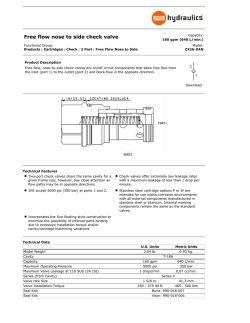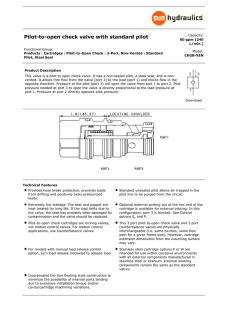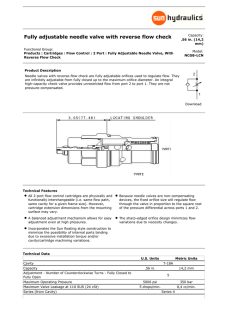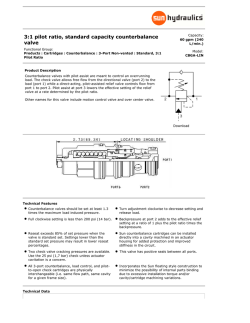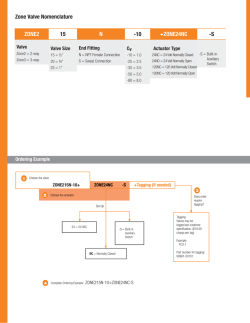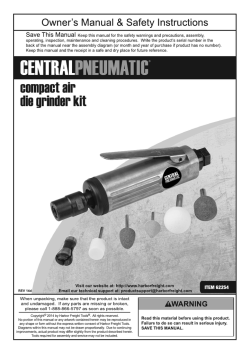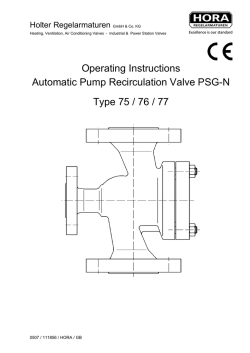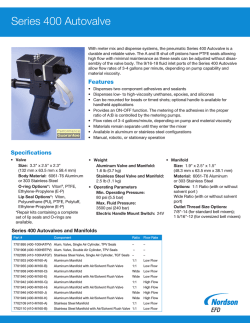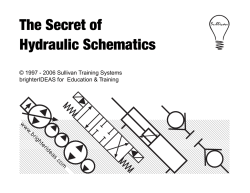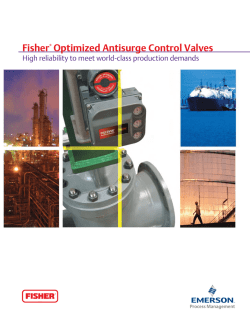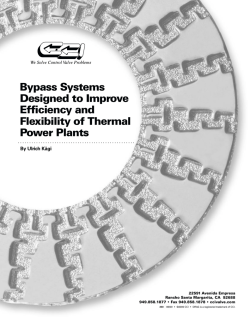
Control Valves Limit Turbine Temperature Swings
still out. Some were redesigned to hold boiler and turbine temperatures relatively constant. Other power plants resorted to sliding-pressure operation to relieve the problem in turbine-generators only, but relatively lengthy ramp times to reach full load still persist. Control valves limit turbine temperature swings Brayton Point valve system design facilitates a large unit conversion from base-load to cyclic operation By Edwin J. Brailey, Jr., New England Power Service Co., and Herbert L. Miller and Curtis G. Sterud, Control Components, Inc. Daily cycling of large generating units that were designed for base load now is an economic necessity for many utilities. And repeated temperature changes common to cycling can result in thermal stress, which may shorten the life of tur- Once-through units New England Power Co. recently installed a system at Brayton Point Unit 3 that is well suited to load cycling. This 650-MW, double reheat, once-through unit originally was designed to operate at full throttle pressure from 150 MW (23% load) to full load. The revised system allows the turbine to operate at about 900 psig (6.2 megapascal, MPa) from no load to 163 MW, at variable pressure and fixed turbine control valves to 553 MW (85% load), and then at full constant pressure to 650 MW. The superheater bypass valve and the pressure-control valves play a critical role in implementing this program. The unit’s original valves were the single-seat, single-stage type. They included two backpressure control valves at the primary superheater inlet, the temperature-control valve at the primary super- bines and boiler parts. The problem was recognized years ago in supercritical and subcritical oncethrough steam generators that were designed for minimum loads of 30% to 50%. Redesign solutions were developed, with varying degrees of success, to permit frequent cycling to much lower loads. One goal had been to reduce turbine temperature change during wide load swings. As for drum-boiler units, the jury is heater outlet, and the pressure-reducing valve at the secondary superheater block valves. Valve service life was limited, and the violent flow through these valves caused vibrations that damaged the actuators and resulted in poor control. The valve stations were noisy. Velocities up to sonic levels led to rapid seat and plug erosion. Three of these valves discharged to the flash tank and continual leakage POWER ENGINEERING/APRIL 1991 47 provides a cushion similar to that of the flash tank for once-through units. Therefore, a controversy continues on the best way to control daily cyclic load swings without incurring turbine thermal-stress damage in drum-boilers of 250 MW and above. Sliding pressure is a popular approach, but this does not protect those boiler components (other than the drum itself) that may be sensitive to rapid and repeated temperature changes. Cycle redesign, incorporating pressure control-valves between the primary and secondary superheaters and a bypass valve that dumps to the condenser, achieves relatively constant temperatures throughout the cycle (turbine and boiler). This modified cycle (Figure 2) allows for the wide and frequent load swings of cyclic operation. problems created unacceptable heat-energy losses. The new approach The new system (Figure 1) allows variable-pressure operation from 163 MW (25% load) to 553 MW (85% load). At loads of up to 163 MW, all steam used in the turbine passes through the flash tank by way of the superheater bypass valve. This valve controls the primary superheater outlet pressure and, over this range of operation, the valve differential pressure is 2550 psi (17.6 MPa). Throttle pressure is maintained at about 900 psig (6.2 MPa) by using the flashtank pressure control valve to bypass steam to the condenser. At loads greater ‘than 30 MW (5% load), the higher primary superheater temperature allows all fluid to flash to vapor and the flash tank is dry. At 163 MW, the superheater bypass valve closes and steam flows directly from the primary to the secondary superheater through the pressure-reducing valves, which now control the primary superheater outlet pressure. From 163 to 585 MW, the turbine control valves remain fixed at about 85%, and the temperature changes in the turbine are kept small. During this load increase, the pressure differential across the valves starts at 2550 psi (17.6 MPa) and drops to about 300 psi (2 MPa) at 560 MW. The superheater block valves then are opened, and the turbine control valves control the constant throttle pressure up to the maximum load. Steam-generator manufacturers have used several strategies to reduce minimum flow through the boiler to 25% or less. They also have other design approaches to maintain relatively constant temperatures during wide and frequent load swings. Because wide-range load cycling was not the goal at Brayton Point Unit 3, minimum flow was kept at 25% full load; In drum-boiler units, the drum itself 48 Valve flow design Wherever large, base-loaded plants have been modified to accommodate cyclic load swings and hold relatively constant turbine temperatures, owner goals have been different. Thus, superheater-bypass valve and pressure-control valve designs have had to be adapted to each plant. In most cases, however, valve disk characterization through a dedicated computer program has proved invaluable in gaining optimum cyclic operation. The following paragraphs discuss a generic situation that is typical of many pressurecontrol and superheater-bypass valve applications . Disk characterization Superheater-bypass valves and pressurecontrol valves are made up of stacks of tortuous-path disks (Figure 3). Hence, discrete groups of disks within each stack can be designed to produce the varying pressure-drop characteristics required at specific valve-stroke positions. The valves can be “characterized” to maintain proper control throughout the ranges of superheater-bypass valve operation up to about 15% load; pressurecontrol valve operation from 15% to 85% load. In this way, the shape of the percent-stroke versus percent-flow curve can be altered to match a specific need. In the case of a superheater-bypass valve, Figure 4 shows Cv (valve flow coefficient) versus stroke needed to produce the characteristics required. Note that three characterizations are required, including a relatively flat mid-section for the 400 F to 600 F (200 C to 3 15 C) operating range. Here the relatively large stroke change versus Cv produces good pressure control during the flat, density-change portion of superheater-bypass valve operation. In the case of the pressure-control valve, operation from as low as 15% load to 85 to 100% load, valve characterization requirements are very different. The goal here is to produce a linear flow versus load characteristic throughout the ramp. Figure 4 shows the Cv vs stroke required. In this case, seven individually characterized groups of disks are needed to control velocity over the load change and keep energy levels manageable to control noise and vibration. Computer design program A dedicated computer program tracks all interrelated design parameters throughout operating ranges and critical loading crossover points. These points are where load is transferred from the superheater bypass valve to the pressure-control valve and from the pressure-control valve to the turbine control valves in ramping up load. The sequence is reversed as load is ramped down. This computer program ensures that no relevant design parameter at any operating point is overlooked. It also ensures optimum single and combined valve operation. Figure 5 shows typical computer plots of pressure- and superheater-bypass valve stroke versus temperature at start-up flow. At this flow rate, temperature is increased to 300 F (150 C) at 600 psig (4.1 MPa) during cold cleanup with the superheater- POWER ENGINEERING/APRIL 1991 bypass valve approximately 50% open. Pressure and temperature are ramped to and MPa) psig (24.1 3500 400 F (205 C) with the valve about 20% open. Then, as temperature is increased with a corresponding reduction in density, the valve opens to about 85% at 800 F (425 C). This is a critical operating zone because it is here that a smooth function transfer occurs from this superheater-bypass valve to the pressurecontrol valve. This reflects the disk-stack characterization shown in Figure 2. Figures 6, 7, and 8 are computer plots of pressurecontrol valve inlet and outlet pressures, flow and stroke from start-up load to 100% load. See Figure 4 for the seven-group characterization required to produce the linearity shown in Figure 6. At 100% load, the approximately 40-psi (.03 MPa) difference between pressure-control valve inlet and outlet pressure (Figure 5) represents the pressure drop through the valve. This could be a twovalve arrangement made up of a modulating pressurecontrol valve and a parallel block valve. The block valve is opened for added capacity at full load. In this case, the pressure-control valve controls load up to about 80% with a pressure drop of about 300 psi (2.1 MPa). Relatively conPOWER ENGINEERING/APRIL 1991 stant , full-load temperature is maintained at the turbine inlet throughout this pressure-control valve ramp. In addition, the program produces many other necessary valve design parameters for small increments of flow change. These include Cv per disk, number of pressure-drop stages per disk, and total Cv at each stroke position. The program also lends itself to field-data analysis where minor differences may exist between original design parameters and actual operating conditions. For example, start-up use of flash tank steam for other purposes may not have been considered in the original design. Field operating comparisons have confirmed that the use of this dedicated computer program contributes to successful valve design. disk stack. This dissipates pressure energy through abrupt turns within individual disks. Because these flow paths are fixed in each disk in the stack, individual disk flow is constant at any degree of modulation through the valve. Water velocities thus are limited to less than 100 ft/sec (30 meters/sec). In steam and two-phase steam/water flow, close velocity control is especially important to keep energy levels manageable and to limit noise and vibration potentials. Velocity control, repeatability An overriding design consideration in these pressure-control and superheater bypass services is to ensure absolute velocity control, repeatability, and resolution for the high differential pressure at the variable flows encountered. The typical disk can be varied by changing the number of right-angle turns to produce different pressure drops. Valve seat design is another important consideration. It must ensure tight closure Valve mechanical design Pressure-control valves and superheater bypass valves should be of the “tortuouspath” design for long life, optimum operation, and load transfer-function control. A typical tortuous-path valve design for severe service features eight disks (3.2 mm disk thickness) per inch in the 49 needed here and, if balanced-plug valves are used, oversized actuators would be needed. However, this valve employs a pressure-seat design with an internal pilot valve to load and unload the closing force on the plug. When the valve is closed, under high pressure differentials every time the valve closes. Many materials and design approaches have been tried over the years in this area of valve design. The typical pressure control valve features a balanced plug design (Figure 9). This valve modulates flow throughout a straight-through operating range up to the point where the turbine throttle valves take over. Pressure differentials vary from about 2800 psi (19.3 MPa) down to 30 to 40 psi (0.2 to 0.3 MPa). That is when the turbine valves take over, Because this pressure-control valve operates in series with upstream and downstream block valves, absolutely tight closure is not a prime design consideration. However, it could be designed as a pressurized-seat valve to eliminate block valves from the system layout. Superheater bypass valves A typical superheater bypass valve (Figure 10) is closed at any load above the point at which flow is transferred to the pressure-control valves. Therefore, it must seat tightly during normal operation. An exceptionally high closing pressure is 50 full upstream pressure behind the plug exerts about 100,000 lb (450 N) of closing force. When the actuator is called upon to open the valve, the internal pilot opens first, bleeding this high pressure downstream through ports within the plug itself. This immediately balances the forces acting on the plug, permitting normal actuator loadings to control valve flow modulation. This superheater bypass valve also functions as a dump valve on turbine trip to conserve condensate and minimize safety relief valve operation. Therefore, it must be capable of absorbing a severe internal thermal shock during rapid heatup. Belleville springs placed between the disks and valve body protect valve integrity by allowing rapid disk-stack expansion independently of the slower valve-body expansion. These pressure-control and superheater bypass valves are not sensitive to actuator design-electrical, pneumatic, or hydraulic. Good valve actuator resolution’ is, however, required to prevent excessive valve/feedpump interaction during cyclic operation. Although l/2% resolution is achievable, experience has shown that these characterized, tortuous-path valves operate satisfactorily in cyclic service with only 1% resolution. Successful operation has been demonstrated at Brayton Point and other power plants where this valve design has been used to facilitate large unit conversion from base-load to cyclic operation. In large measure, the dedicated computer program has contributed significantly to END those successes. References Baer, R. H. and D. Turbiville, “Modifying Supercritical Pressure Boilers for Sliding Pressure Control,” POWER ENGINEERING, January 1985, pp 58-60. Electric Power Research Institute, Interim Report, GS-6772, “Variable Pressure Operation, An Assessment,” March 1990. Laney, B. E. and R. L. G. Vera, “Adaptation of a Supercritical Unit to a Present and Future Generation Management Plan,” 25th Power Instrumentation Symposium, Instrument Society of America, Phoenix, Ariz., May 24-26, 1982. Laszlo, J. and B. K. Chan, “PG&E Experience in Cycling Conversion of Gas-Fired Supercritical Power Plants,” Electric Power Research Institute Seminar on Fossil Plant Cycling, Princeton, N.J., October 20-22, 1987. Miller, H. L. and C. G. Sterud, “A High Pressure Pump Recirculation Valve, ” Electric Power Research Institute, Power Plant Valve Symposium, Kansas City, MO ., August 1987. Miller, H. L. and C. G. Sterud, “Replacement Pressure Control and Superheater Bypass Valves Permit 93% Cyclic Load Cutback at PG&E’s 750-MW Units at Moss Landing, ’ ’ American Power Conference, Chicago, Ill., April 24-28, 1989. Budd, A. H. and 0. W. Durrant, “Designs and Systems for Large Fossil Fuel Units Intended for Cycling Service,” American Power Conference, Chicago, Ill., April 29May 1, 1974. Schaeper, W. and R. L. G. Vera, “Modifying Supercritical Pressure Units for Cycling Operation.” POWER ENGINEERING, June 1984, pp 54-57. AUTHORS Edwin J. Brailey, Jr. i s a project engineer with New England Power Service Co. He holds BS and MS degrees in mechanical engineering from Iowa State University. Herbert L. Miller is vice president of operations with Control Components Inc. He holds a BS degree in mechanical engineering from Ohio Northern University and an MS degree in mechanical engineering from Northwestern University. Curtis G. Sterud is a principal engineer with Control Components Inc. He attended Long Beach City College and Compton Junior College. POWER ENGINEERING/APRIL 1991
© Copyright 2026
